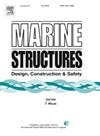A frequency domain method for fully coupled modelling and dynamic analysis of floating wind turbines
IF 4
2区 工程技术
Q1 ENGINEERING, CIVIL
引用次数: 0
Abstract
In design of Floating Wind Turbines (FWTs), balancing computational efficiency with analytical accuracy is crucial, a challenge often unmet by time-domain methods. This study innovatively develops and verifies an efficient frequency domain method for fully coupled modelling and dynamic analysis of FWTs, termed DARwind-FD. The tower of the FWT is conceptualised as a beam, with the rotor-nacelle assembly (RNA) and the floating platform envisaged as rigid bodies situated at each extremity. The aerodynamic loads are evaluated utilising the Blade Element Momentum (BEM) theory, supplemented with an analytical model accounting for added mass and damping. The hydrodynamic loads are assessed through the Linear Potential Flow theory, taking into account both first and second-order wave forces along with viscous effects. The mooring forces are analysed using a linearised stiffness matrix, derived from a quasi-static catenary methodology. The code-to-code verification of DARwind-FD is based on the OC4 DeepCwind semi-submersible platform with a 5MW wind turbine, aligns well with OpenFAST time-domain results in terms of dynamic responses such as platform motions, mooring tension, tower base bending moment, and nacelle acceleration under various conditions. The outcomes of this research offer robust technical support for the preliminary design and optimisation of FWTs, thereby contributing to the sustainable advancement of offshore wind energy systems.
用于浮动风力涡轮机全耦合建模和动态分析的频域方法
在浮动风力涡轮机(FWT)的设计中,平衡计算效率与分析精度至关重要,而时域方法往往无法应对这一挑战。本研究创新性地开发并验证了一种高效的频域方法,用于浮动风力涡轮机的完全耦合建模和动态分析,称为 DARwind-FD。FWT 的塔架被设想为梁,转子-机舱组件 (RNA) 和浮动平台被设想为位于两端的刚体。空气动力载荷利用叶片动量(BEM)理论进行评估,并辅以考虑了附加质量和阻尼的分析模型。流体动力载荷通过线性势能流理论进行评估,考虑了一阶和二阶波力以及粘性效应。系泊力采用线性化刚度矩阵进行分析,该矩阵由准静态导管法得出。DARwind-FD 的代码对代码验证基于装有 5MW 风力涡轮机的 OC4 DeepCwind 半潜式平台,在平台运动、系泊张力、塔架基座弯矩和机舱加速度等动态响应方面与 OpenFAST 时域结果非常吻合。这项研究成果为全功率变流器的初步设计和优化提供了强有力的技术支持,从而为海上风能系统的可持续发展做出了贡献。
本文章由计算机程序翻译,如有差异,请以英文原文为准。
求助全文
约1分钟内获得全文
求助全文
来源期刊

Marine Structures
工程技术-工程:海洋
CiteScore
8.70
自引率
7.70%
发文量
157
审稿时长
6.4 months
期刊介绍:
This journal aims to provide a medium for presentation and discussion of the latest developments in research, design, fabrication and in-service experience relating to marine structures, i.e., all structures of steel, concrete, light alloy or composite construction having an interface with the sea, including ships, fixed and mobile offshore platforms, submarine and submersibles, pipelines, subsea systems for shallow and deep ocean operations and coastal structures such as piers.
 求助内容:
求助内容: 应助结果提醒方式:
应助结果提醒方式:


